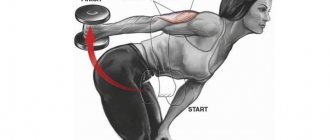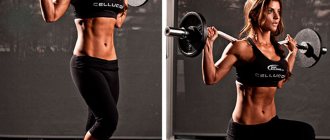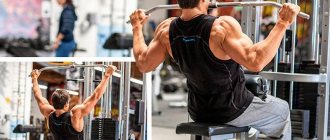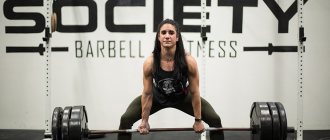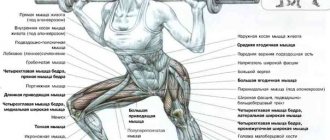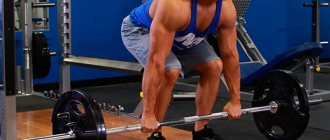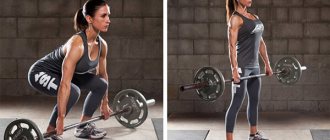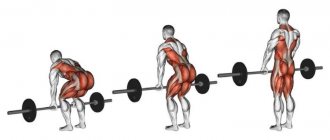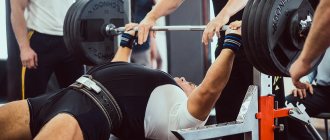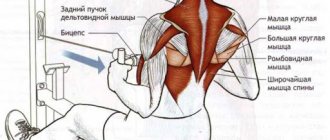Let's decide on priorities
The article is primarily for those who, having forgotten wrist straps at home and not finding them in the gym, cannot train normally. Because any weight, more than two-thirds of your own weight, simply falls out of your hands. And also for people who tie themselves to the horizontal bar, even if they do pull-ups without weights on their belt. That is, they are simply unable to hold their own weight hanging for 20-30 seconds.
Someone will smile, they say, this doesn’t happen. Well, I'm glad for you and that you managed to avoid beginner mistakes by developing sufficient grip strength. But there are few such people. I constantly see a funny picture in gyms when, working even with average weights in blocks, on a barbell and not with the heaviest dumbbells, people constantly use wrist straps.
Some people make excuses like, “I’m taking the extra load off my forearms so I can focus on the working muscle group and not think about my arms.” This seems reasonable. But, unfortunately, it only seems. In fact, abuse of wrist straps not only leads to stagnation in the development of the muscles of the forearms, but even to their degradation.
That is, below we will talk about the reasonable development of grip strength in order to avoid imbalance in the hands. And for further strength progress in general, this is useful.
As for extreme work on developing the strength of fingers and forearms, when nails and coins are bent and an iPhone is crushed in a fist, this is a topic for a separate article and is not relevant to today’s conversation.
Pros and cons of neutral grip pull-ups
Advantages of parallel grip pull-ups:
- The exercise develops a large number of muscles.
- It is a highly effective way to develop strength and volume.
- Allows you to simultaneously make your back wider and thicker.
- Helps improve the performance of various basic exercises.
The disadvantage of the exercise is the use of a special horizontal bar. Of course, you can come up with an alternative to such sports equipment, but in this case you will have to get used to and adapt to a less comfortable and convenient implementation.
What to do to effectively develop your grip
First of all, don't waste your time on useless exercises. Especially in the early stages of working with weights. We are talking about various kinds of flexion and extension of the hands with a barbell and dumbbells, such as these:
I have never seen a person who really pumped up their forearms with such exercises, and I tried it myself in the past - nothing worked. But to injure your hands with them - once or twice!
The fact is that with a reasonable increase in the weight of the weights, the forearms adapt to the load easily and naturally . Moreover, the load is quite large, which I will talk about a little later using my own example.
But there are several conditions.
First, don't use gloves . It seems that they even increase the load - if you are not used to it, it can be even more difficult to hold a barbell or block than without gloves. It's just out of habit. In reality, gloves (especially good, branded and expensive ones) steal part of the load from the forearms, increasing the friction force between the palm and the barbell or horizontal bar. That is, it is easier to hold them.
There is one advantage of gloves - calluses do not appear. But this is more relevant for girls. Although I can’t say that calluses on the inside of the palm are very noticeable and somehow negatively affect a person’s appearance as a whole.
Second, use a full lock (thumb grips the bar/horizontal bar from below), and not a bear grip (thumb on top) . The latter also makes the work easier, and in this mode the muscle chain is disrupted and the forearm works, as they say, for wear and tear.
Without going into anatomical details, muscles, tendons and fascia are a single system, the disruption of individual components of which leads to problems in other parts. Take the same squats with a barbell, which, with the correct technique for performing the exercise, are safe for the knee joints, since the muscles stabilize them. If the technique is incorrect, on the contrary, you can get a lot of trouble with your knees. It's the same story with the forearms.
Third, try not to use wrist straps until you reach critical weights. The problem with wrist straps is that not only do they take some of the load off the forearms, but they also put pressure on the hands, disrupting blood flow and pinching nerves. The brain's response to such bullying is to send a signal to relax the muscles of the forearms. That is, it seems like you are pulling more and more weight, and your forearms are working worse and worse, to the point of degradation.
Reverse grip
A reverse grip is when you place your hands shoulder-width apart with your palms facing outward. Your forearms should be perpendicular to the floor. Keep your elbows strictly at your sides, and never spread them out to the sides. When performing a bench press with a reverse grip, the main emphasis of the load falls on the triceps and the upper (clavicular) section of the pectoralis major muscle.
Bench press on a horizontal bench with a reverse grip
Personal experience in grip development
I’m ashamed to admit, but there were times when I couldn’t hold myself on the horizontal bar for long and used wrist straps when doing pull-ups. But what about pull-ups, you pull a 70 kg block to your chest (with your own weight of 110 kg) and also with straps. You do a deadlift with 80 kg or a barbell row to the stomach - again with straps. This is all strange and inconvenient. After all, I actually forgot my sports accessories at home several times, and training turned into a nightmare, since the local equipment left much to be desired.
Moreover, it was during those times that I tried to actively load my forearms with all sorts of flexion and extension of the wrists, farmer’s walks, expanders, squeezing the ball with my fingers... all in vain. My grip strength didn't increase much.
I also used gloves. Almost got rid of calluses, but little joy.
At one point I realized that I had to somehow solve the problem and it was not a weak joint-ligamentous system, but the very “crutches” that I used every day. An attempt to load the hands with additional exercises did not yield results.
Of course, I didn’t want to roll over the scales, because it seemed that I wouldn’t be able to work without straps, but the devil is not as scary as he is painted to be.
In fact, the forearms adapt to the load very quickly, especially if you warm up your hands well, plus give them a little prophylaxis at the end of the workout.
Prevention is simple - rotate your hands left and right 20-30 times, thoroughly knead the pronator quadratus muscle with circular movements of your thumb, then wrap your hands with an elastic bandage without squeezing them, and leave it for several hours. This will improve nerve conduction of the muscles (innervation) or restore it if it has already been damaged by abuse of straps.
At first it was a little uncomfortable, the usual weights tried to escape from my hands, I had to strain more. Then he took a week’s rest from training and returned to work, reducing the load by 30-40%. I increased it very smoothly. A month later I got to my usual working scales, but without straps. This did not cause any problems. The increase in load occurred systematically, the forearms did not become a limiting factor.
Currently, I have no problems holding myself on the horizontal bar without straps, when doing pull-ups with a weight of 30+ kg on my belt. I also do deadlifts with a weight of 130-140 kg without any additional accessories. At the same time, my own weight is 102-103 kg. When the barbell weighs more than 140 kg, then I put on straps, because the muscles of the back and legs are pulling, but my fingers can’t hold it (yet).
I noticed that after strengthening my grip, problems with my hands, minor injuries, pain and inflammation disappeared. It also stopped “hammering” my forearms during back training, especially after pulling blocks.
Parallel grip pull-up technique
The technique for performing parallel pull-ups is very simple. However, there are a few nuances that you should know. Let's look at the option with a narrow position of the hands .
- The starting position is hanging with outstretched arms. The grip is naturally parallel.
- As you exhale, an upward movement is performed. You should strive to touch the crossbar with your chest. The range of motion in this exercise should not be stingy.
- At the top point of the amplitude, you should linger for a few seconds, then slowly lower, taking the starting position.
- The return movement is performed while inhaling.
Performance:
1.Remove the bar from the racks. We do this under control; if possible, ask someone in the gym to back you up and help you remove the barbell.
2We inhale as deeply as possible and stick our chest out as much as possible, while the pelvis and shoulder blades should remain pressed to the bench. It’s good to rest your feet on the floor.
3.Under control, without throwing, lower the barbell to the middle of the chest until the bar lightly touches the chest.
4.Straighten your arms and forcefully press the barbell up to the starting position.
5.After we have completely straightened our arms at the elbow joint, we exhale.
Tips for Maximum Productivity
There are several tips that will help you get the most out of this exercise. Remember them and your pectoral muscles will thank you.
—After removing the barbell from the racks, pause for 2-3 seconds to stabilize the position of your body and the barbell does not wobble from side to side.
— Try to do the bench press with a barbell first in your training program, then you will be able to work with heavier weights as you will have more strength.
—Be sure to do 2-3 warm-up sets before starting to work with heavy weights (working sets). This will warm up your chest muscles and prepare your nervous system for heavy loads.
—Take an average of 3 to 5 minutes of rest between heavy sets. During this time, the muscles will have time to recover properly.
— Find a partner in the gym whose bench press result is much higher than yours and strive to surpass him. This will add motivation to you and help you achieve the desired result.
Recommendations
And finally, I would like to give a few recommendations that will help you avoid the most common mistakes and organize your training correctly.
- Try to perform the exercise using the strength of your back muscles, not your arms.
- Keep the bar as close to your body as possible, allowing it to glide over it easily.
- Watch the position of your elbows. With a narrow grip, they should rise up, with a wide grip, no higher than shoulder level.
- Try to perform the exercise in front of a mirror to monitor the position of your body. It should not lean back or forward.
- The barbell row should be performed without jerking, as smoothly and deliberately as possible both when lifting and when returning to the starting position.
- Do 3-4 approaches as many times as possible. The last pull should be at the limit of strength.
- Take adequate weight so as not to cause a muscle tear, but at the same time get a good effect from the workout.
- Be sure to warm up before performing barbell exercises. Cold muscles are not able to work at full strength.
- Watch your back. It should be smooth and straight. Any deflection is fraught with unpleasant consequences such as sprains and a long pause in training with a rollback of results.
- Even if you don't plan to become a professional bodybuilder, incorporate deadlifting into your program. It will help to evenly work out the muscles, improve the overall body shape and endurance, and also strengthen the spine and give good posture.
